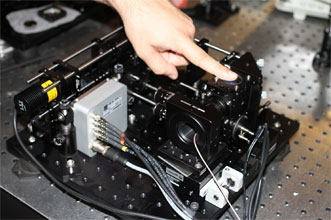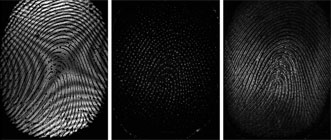Photonics HandbookResearch & Technology
Application Note: OCT System Captures 'Internal' Fingerprints
PARIS, Dec. 17, 2015 — A sensor system based on full-field optical coherence tomography (FF-OCT) can distinguish real fingerprints from fakes by imaging deeper.
Most traditional fingerprint-scanning devices use an optical camera to take pictures of only the top layer of skin. Along with being tricked by physical fingerprint dummies, the devices also can fail to recognize legitimate prints when the finger is dirty, worn, scarred, too wet or too dry.

An 'internal' fingerprint identification system. Courtesy of BitFlow.
Scientists from the Langevin Institute in Paris have developed a fingerprint imaging system that peers inside the finger for more reliable identification. The system can also image sweat pores, which provide an additional means of identification.
It was developed by Egidijus Auksorius, a postdoctoral researcher, and Claude Boccara, a professor who specializes in scientific instruments. Boccara's laboratory developed the FF-OCT system, on which the fingerprint sensor is based, in the early 2000s.
Standard OCT gathers 3D data and requires high-tech lasers. FF-OCT, on the other hand, can use a spatially and temporally incoherent source and is based on a 2D detector, so it's faster, less expensive and easier to deploy for recording en face images such as fingerprints. The technique works by analyzing the interference patterns created when light coming from a predetermined depth of a biological sample is recombined with a reference beam.

Comparison of an external fingerprint imaged conventionally (left) with sweat pores (center) and an internal fingerprint (right) imaged using full-field optical coherence tomography. Courtesy of BitFlow.
BitFlow Inc., a machine vision technology provider in Woburn, Mass., contributed to the system's design. Its Cyton CXP4 CoaXPress frame grabber allowed the interface of an Adimec 2-MP CXP-6 camera with the system's host computer without requiring external power supplies or extra cables to uplink communications.
In an earlier study, Auksorius and Boccara used an expensive InGaAs camera but have since recorded fingerprint images of a similar quality using the Adimec camera, thanks to its high frame rate and the pixels' high full-well capacity. A compact LED source emitting at 780 nm was used to provide illumination.
The frame grabber can capture video at speeds of up to 6.25 Gb/s. Simultaneously, control commands and triggers can be sent to the camera at a rate of 20 Mb/s, and up to 13 W of power can be supplied to the camera.
The researchers captured images of internal fingerprints in <1 s, a speed adequate for live fingerprint imaging applications, as any finger movement compromises image quality. With its four links, the frame grabber minimized acquisition time using a CoaXPress Quad (4 × CXP-6) configuration, allowing the camera to operate at a total data rate of 25 Gb/s.
/Buyers_Guide/BitFlow_Inc/c1818